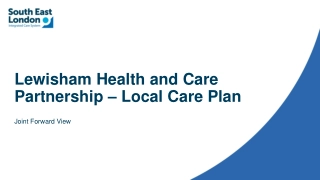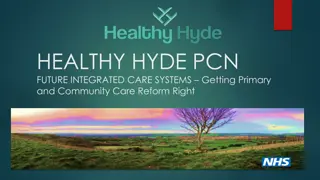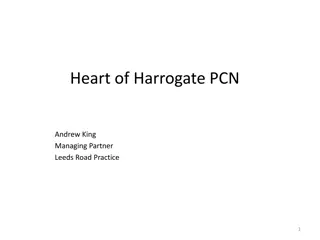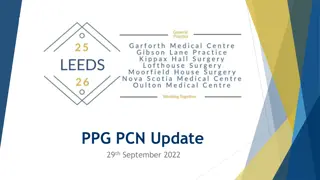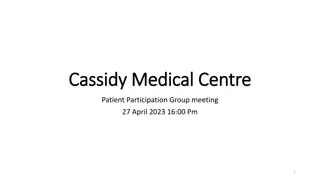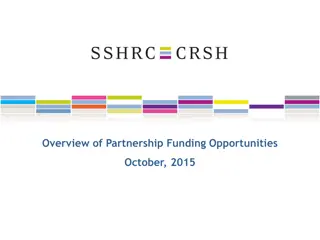
Potential Advantages and Concerns of GP Primary Care Networks
Explore the advantages and concerns related to GP Primary Care Networks (PCNs) as detailed by Dr. Nigel Watson. The document delves into challenges faced by general practice, the shift towards population-based health, and the future of primary care in the NHS. Key issues like workload management, workforce struggles, and the need for investment are highlighted. Learn about the development of PCNs in local areas and their role in strengthening general practice by focusing on the health of defined populations.
Download Presentation

Please find below an Image/Link to download the presentation.
The content on the website is provided AS IS for your information and personal use only. It may not be sold, licensed, or shared on other websites without obtaining consent from the author. If you encounter any issues during the download, it is possible that the publisher has removed the file from their server.
You are allowed to download the files provided on this website for personal or commercial use, subject to the condition that they are used lawfully. All files are the property of their respective owners.
The content on the website is provided AS IS for your information and personal use only. It may not be sold, licensed, or shared on other websites without obtaining consent from the author.
E N D
Presentation Transcript
GP Primary Care Networks PARTNERSHIP REVIEW A Personal View This document is intended to explore some of the potential advantages of PCNs in addition to addressing some of the concerns and confusions relating to their function and purpose. Dr Nigel Watson: GP Chief executive Wessex LMCs Member of the GPC Independent Chair of the GP Partnership Review Involved in the development of the Primary Care part of NHS England s Long Term Plan Member of the LETB Health Education England (South) Executive Board Member Hants & IoW STP 1
GP Key issues for general practice? PARTNERSHIP REVIEW Challenges Impact on general practice Workload becoming unmanageable Workforce struggles to meet demand Working day becoming unmanageable Recruitment of younger GPs Retention of older GPs Stress, burnout, mental health Organisational barriers Ageing population Population growth More people with long term conditions Over dependency on hospital based care Lack of investment in general practice and community services 2
GP Population based health PARTNERSHIP REVIEW The NHS has funded care in hospitals based on activity. This was to increase capacity and address demand at a time when the NHS was receiving significant growth in funding year on year. General practice, community and mental health services have historically been funded on a capitation based formula. This has resulted in a significant growth in the acute sector at the expense of the services funded on a capitation basis, but has also created a perverse incentive to change. Population based health begins to address some of these issues and looks at outcomes rather than activity. It seeks to improve the health of a defined population by prevention, early diagnosis and more effective treatment and management. Services need to be commissioned and delivered at the most appropriate population size. It is generally accepted that the following are appropriate: Practice 8,000 average size, organized care around registered list of patients Neighbourhood PCN, community based population 30-50,000 Place 100 200,000 population System often footprint of hospital population 500,000 Region population 2-5,000,000 3
GP Primary care and the future PARTNERSHIP REVIEW All of these documents were published in January 2019 and demonstrate the most significant commitments to general practice for many years. The common theme in all 3 documents is Primary Care Networks. Each document describes how these networks build on existing developments in local areas, strengthening general practice by working in models based on a population of 30-50,000 with a focus on the health of the population based in that community. To achieve this there needs to be investment, additional workforce and incentives to deliver the transformation. GP Partnership Review Commissioned by Secretary of State for Health and Social Care May 2019 Reported December 2019 Independent Chair: Dr Nigel Watson MBE MBBS FRCGP 4
GP NHS Long Term Plan focus on primary care PARTNERSHIP REVIEW Two of the key aims is to boost out of hospital care and dissolve the historic divide between primary and community care. It is difficult to address the workload in hospital if the rest of the system also experiences a lack of investment and a decline in the workforce. We know that there are less GPs now than there were 5 years ago, and district nurse numbers have also declined in the same timescale. In Hampshire and the Isle of Wight, the number of staff employed in the hospitals has increased by over 5% since 2015, and during the same time period numbers of primary care staff have decreased by 8.8%. The Long Term Plan commits an additional 4.5bn per year (increased from the original 3.5bn) by 2024. This investment guarantee will fund an expanded workforce, start to address the demand pressures and develop new services to meet relevant goals set out in the long term plan. To achieve this every area will have the opportunity to establish Primary Care Networks covering a population of between 30-50,000 based in a community supporting each practice in the PCN. The PCN will be formed of member practices, incentivised to work together via the GP Contract with funding made available to individual practices and to the PCN via practice membership. There will now be a requirement that community nursing and mental health teams will be configured on PCN footprints. 5
GP What are Primary Care Networks? PARTNERSHIP REVIEW Population size: 30-50,000 Geographically based Built on member practices GP led An extension of the GP practice Local delivery unit 6
GP How will Primary Care Networks operate? PARTNERSHIP REVIEW There is a risk that PCNs become the answer to everyone's problem and they are prevented from doing what they were intended to achieve. The NHS is often criticised for working within organisational silos. The PCN are one route through which these historic barriers will be removed. In my view there are 4 very clear and different elements to PCNs: Working on behalf of their member practices 1 A PCN is not an organisation or an established legal entity. It is formed of practices who agree to work collaboratively with each other for the benefit of the population they serve, and will form an essential part of the community. The PCN will receive funding for additional staff and a clinical lead to enable the member practices to start to address the major issue of workload. In return for the additional funding there will be a requirement for the PCN to make use of these additional members of staff to improve the health of their population by delivering the service specifications that will be agreed each year with the profession and delivered at PCN level. The core PCN should therefore be considered as an extension of the member practices. 7
GP How will Primary Care Networks operate? PARTNERSHIP REVIEW An alliance of providers using existing resources to greater effect 2 The PCN will have a second important function which is to lead a carenetwork consisting of community and mental health staff, who will have teams configured around the footprint of the PCN and become an integrated part of the delivery of care to that population and community. These teams will be expanded in terms of people via the commitment in the LTP to invest in community and mental health staff. This is above and beyond the commitment to invest in PCNs and primary medical care. Together with GPs, they will form the basis of the MDT for the PCN. For full integration, it is essential that these teams work as one with GPs and practices, are co-located with general practice wherever possible, use the same electronic patient record, and are locally accountable. Expanded neighbourhood teams will comprise a range of staff such as GPs and SAS doctors, pharmacists, district nurses, community geriatricians, dementia workers and AHPs such as physiotherapists and podiatrists/ chiropodists, joined by social care and the voluntary sector. Other important providers who could play a role will be hospitals, the local authority, and the voluntary sector, who could deploy some of their resources at PCN level. 8
GP PARTNERSHIP REVIEW How will Primary Care Networks operate? What does removing the historic divide between primary community care really mean? The NHS Long Term Plan states: GP Practices typically covering a population of 30-50,000 - will be funded to work together to deal with pressures in primary care and extend the range of local convenient services, creating a genuinely integrated teams of GPs, community health and social care staff. District Nursing service will be required to be configured on PCN footprints . Expanded teams based in PCNs will comprise a range of staff such as GPs, SAS Doctors, pharmacists, district nurses, community geriatricians, dementia workers and AHPs such as physiotherapists and podiatrists, joined by social care and the voluntary sector. The GP Partnership Review recommended: Multi-professional community health teams should be based in primary care networks and work under the clinical and service direction of the PCN. They could remain employed by their existing employer while being more closely partnered with, and embedded in, practices day to day. This should include creating a single team using a common health record, sharing the same caseload, and removing the need for referrals. Wherever possible, the community team should also be co- located with the constituent practices of the network. 9
GP PARTNERSHIP REVIEW How will Primary Care Networks operate? To remove the historic divide between primary and community services, creating teams that work within a PCN footprint and truly integrate will require some radical change, with the risk that little happens because it is seen as being too difficult. To be effective, general practice and community staff need to work as a single team. To achieve this there needs to be local accountability within the PCN and a common health record, with read-write and messaging capability and co-location wherever possible. With the development of MSK first point of contact practitioners, there is the opportunity to deploy existing community physiotherapy resource to the PCN to work in partnership with them, not only to make more effective use of this service but also to address some of the rising demand in hospital clinics. Delivering more care in the community also has the potential to develop the workforce, with the potential for more portfolio career options. This model could also be used for other specialist services. Transforming hospital based care in terms of outpatients must look at more effective ways of follow up and monitoring and moving more care (with resources) locally. Examples include the paediatric hubs serving a population of 30-50,000 based in a practice in a PCN, using the GP record, and a consultant working with a GP who is becoming an extended scope practitioner. This model could be expanded to diabetes, respiratory care, and dermatology for example. 10
GP How will Primary Care Networks operate? PARTNERSHIP REVIEW As a delivery unit working with a range of providers 3 As the carenetwork develops and the number of staff expand, the risk of one practice employing up to 20 new staff members will become too great. My expectation would be that some PCNs will form a legal entity, probably a company limited by shares, that will form part of the PCN and be able to hold that risk and employ staff etc. This organisation could then be a vehicle for delivering more services commissioned by the NHS. There would also be the potential for creating a joint venture with other providers. Examples could be a community based diabetes service, respiratory service, wound care, cardiovascular, frailty etc. 11
GP How will Primary Care Networks operate? PARTNERSHIP REVIEW Education and training 4 The LTP states that each PCN will be a training hub or connected to a training hub. This will ensure that PCNs have an important relationship with Health Education England. GP practices are used to training GPs, but PCNs could develop their workforce and add capacity by training other health care professionals such as student and qualified nurses, pharmacists, MSK practitioners, mental health worker, paramedics. A greater proportion of medical student training needs to take place in primary care, as this is where over 50% will ultimately work. There will become more opportunities to have PCNs forming part of specialist rotations. For example, a geriatric or diabetic trainee could gain considerable experience by working in the community, based in a PCN. The GP Partnership Review recommended that there should be GP and Nurse Primary Care Fellows. These would be newly qualified clinicians who would further develop their careers, placed in a PCN, and would work across more than one practice. They will have support for personal development and the opportunity to develop a clinical area of interest, which may for some evolve into a role as an extended scope practitioner. 12
GP Core Primary Care Networks PARTNERSHIP REVIEW Core Network Practices Funding 2019/20 Via Directed Enhanced Service to PCNs Clinical Director 2 sessions per week Social Prescribing Link Additional staff Worker and Pharmacist 2019/20 1.50 per patient Administration Via Statement of Financial Entitlement (SFE) to Practices For participation in PCN 1.76 per weighted patient Workload is a key issue for general practice, and to help address this there needs to be a significant expansion of the workforce. The PCN DES will ensure that over the next 5 years there will be a significant expansion of the workforce supporting general practice. This is essential for the sustainability of general practice. In addition there will be a financial incentive for practices to work collaboratively in their communities to develop and support a more community based model of care, and reduce the growing dependency on hospital based care. 13
GP Care Networks PARTNERSHIP REVIEW Providers of care services in the PCN footprint: Community teams Mental health teams Local Authority Hospitals Core Network Practices Voluntary sector The wider PCN may have a Partnership Board which will include other providers who, to a greater or lesser extent, will have resources that they will wish to deploy in the community served by the PCN. This Board will not decide on the funding or deployment of staff received by the PCN via the DES. Community Nursing team will be required to configure to reflect the PCN footprint and to work as a single MDT with the member practices. Community Mental Health team will be required to configure on the PCN Footprint some services such as dementia will need to be integrated with primary care. Local authorities can make a significant contribution in a number of areas. Hospitals some services better delivered at community level could be moved from hospitals to PCNs where appropriate e.g. care of the elderly, diabetes, respiratory care, MSK etc. 14
GP Primary Care Networks Plus PARTNERSHIP REVIEW Providers of care services in the PCN: Services that could be provided at PCN level: Leg ulcer care Dermatology Diabetes Respiratory care Frailty Low risk skin cancer care Cardiovascular care, MSK Dementia care Community teams Mental health teams Local authority Hospitals Voluntary sector Core Network Practices Local Subcontracting The PCN is based in a community and should be considered as a delivery unit of care, that will become the investment vehicle of choice in the future. Relationships GP Federation (e.g. providing extended access) Other Organisations Patient groups Schools Council To achieve this structures will need to mature and evolve. 15
GP PARTNERSHIP REVIEW Network services A number of network services will be developed in line with NHS England s Long Term Plan, and phased into the DES over the coming years. 2019 Extended Hours access integrated into networks same requirements as the DES, for 100% of network population 2020 Structured medication review Enhanced health in care homes Anticipatory care (with community services) Personalised care Supporting early cancer diagnosis 2021 Cardiovascular disease prevention and diagnosis, through case finding Action to tackle inequalities 16
GP What could PCNs achieve by 2024? PARTNERSHIP REVIEW 1. Independent Contractor model has had a shot in the arm and has offered an opportunity for a new generation of GPs to become partners. 2. Additional staff PCNs have made 100% usage of the additional roles allowance, with 20,000 more staff working in primary care. 3. Investment vehicle of choice, with increased spend on primary and community care and increased capital spend. The investment should mean that an ever increasing % of the NHS budget is spent on primary and community care. 4. PCNs look out and not in and dissolve the divide between primary and community services. 5. Clear improvement, which is delivered and measurable, in: Improved early diagnosis of cancer Early detection and improved management of hypertension and atrial fibrillation Reduction of polypharmacy Improvement quality services to care homes Development of personalised care 17
GP Primary Care Networks 2024 (first five years of PCNs) PARTNERSHIP REVIEW 2024 funding for additional 20k WTE staff Historic divide between Primary and Community Care removed Community staff District Nurses and Community Mental Health New Services Partnerships with other providers Partnering with local community Investment vehicle of choice Many services could be organised around populations of 30-50k Improve quality of clinical care Reduce polypharmacy Improve quality of services to care homes Develop personalised care Expand specialist capacity and opportunities for portfolio careers Estates 18
GP What do Primary Care Networks mean for general practice? PARTNERSHIP REVIEW Make general practice a better place to work Helped with workload Expanded the workforce Created new opportunities for GPs and others General practice has a leadership role within primary care General practice has a voice in the system 19


